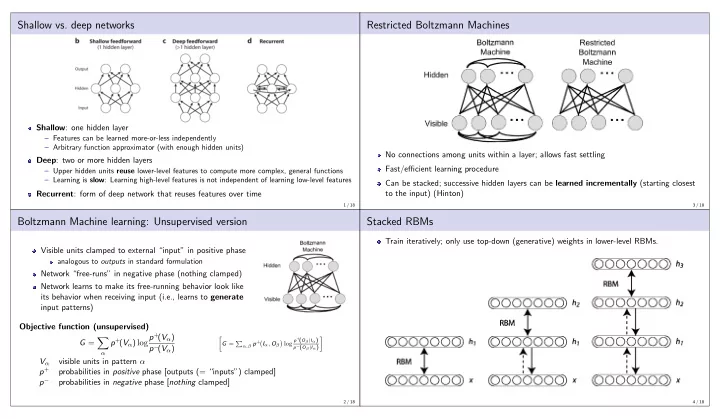

Shallow vs. deep networks Restricted Boltzmann Machines Shallow : one hidden layer – Features can be learned more-or-less independently – Arbitrary function approximator (with enough hidden units) No connections among units within a layer; allows fast settling Deep : two or more hidden layers Fast/efficient learning procedure – Upper hidden units reuse lower-level features to compute more complex, general functions – Learning is slow : Learning high-level features is not independent of learning low-level features Can be stacked; successive hidden layers can be learned incrementally (starting closest to the input) (Hinton) Recurrent : form of deep network that reuses features over time 1 / 18 3 / 18 Boltzmann Machine learning: Unsupervised version Stacked RBMs Train iteratively; only use top-down (generative) weights in lower-level RBMs. Visible units clamped to external “input” in positive phase analogous to outputs in standard formulation Network “free-runs” in negative phase (nothing clamped) Network learns to make its free-running behavior look like its behavior when receiving input (i.e., learns to generate input patterns) Objective function (unsupervised) p + ( V α ) log p + ( V α ) � p + ( O β | I α ) � � G = α,β p + � G = � � I α , O β log p − ( O β | I α ) p − ( V α ) α V α visible units in pattern α p + probabilities in positive phase [outputs (= “inputs”) clamped] p − probabilities in negative phase [ nothing clamped] 2 / 18 4 / 18
Deep autoencoder (Hinton & Salakhutdinov, 2006, Science ) Digit reconstructions (Hinton & Salakhutdinov, 2006) PCA reconstructions Network reconstructions (2 components) (2-unit bottleneck) 5 / 18 7 / 18 Face reconstructions (Hinton & Salakhutdinov, 2006) Document retrieval (Hinton & Salakhutdinov, 2006) Network (2D) Latent Semantic Analysis (2D) Top: Original images in test set Middle: Network reconstructions (30-unit bottleneck) Bottom: PCA reconstructions (30 components) 6 / 18 8 / 18
Deep learning with back-propagation Deep learning with back-propagation: Technical advances Huge datasets available via the internet (“big data”) Sigmoid function leads to extremely small derivatives for early layers Application of GPUs (Graphics Processing Units) for very efficient 2D image processing (due to asympototes) Linear units preserve derivatives but cannot alter similarity structure Rectified linear units (ReLUs) preserve derivatives but impose (limited) non-linearity Net input Often applied with dropout : On any given trial, only a random subset of units (e.g., half) actually work (i.e., produce output if input > 0). Krizhevsky, Sutskever, and Hinton (2012, NIPS) 9 / 18 11 / 18 Online simulator What does a deep network learn? Feedfoward network: 40 inputs to 40 outputs via 6 hidden layers (of size 40) Random input patterns map to random output patterns (n = 100) Compute pairwise similarities of playground.tensorflow.org representations at each hidden layer Compare pairwise similarities of hidden representations to those among input or output representations ( ⇒ Representational Similarity Analysis ) Network gradually transforms from input similarity to output similarity 10 / 18 12 / 18
Promoting generalization Long short-term memory networks (LSTMs) Prevent overfitting by constraining network in a general way – weight decay, cross-validation Train on so much data that it’s not possible to overfit – Including fabricating new data by transforming existing data in a way that you know the network must generalize over (e.g., viewpoint, color, lighting transformations) – Can also train an adversarial network to generate examples that produce high error Constrain structure of network in a way that forces a specific type of generalization – Temporal invariance Long short-term memory networks (LSTMs) Time-delay neural networks (TDNNs) – Position invariance Convolutional neural networks (CNNs) 13 / 18 15 / 18 Long short-term memory networks (LSTMs) Time-delay neural networks (TDNNs) Learning long-distance dependencies requires preserving information over multiple time steps Conventential networks (e.g., SRNs) must learn to do this LSTM networks use much more complex “units” that intrinsically preserve and manipulate information 14 / 18 16 / 18
Convolutional neural networks (CNNs) Deep learning with back-propagation: Technical advances Huge datasets available via the internet (“big data”) Hidden units organized into feature maps (each using Application of GPUs (Graphics Processing Units) for very efficient 2D image processing weight sharing to enforce identical receptive fields) Subsequent layer “pools” across features at similar locations (e.g., MAX function) Krizhevsky, Sutskever, and Hinton (2012, NIPS) 17 / 18 18 / 18
Recommend
More recommend